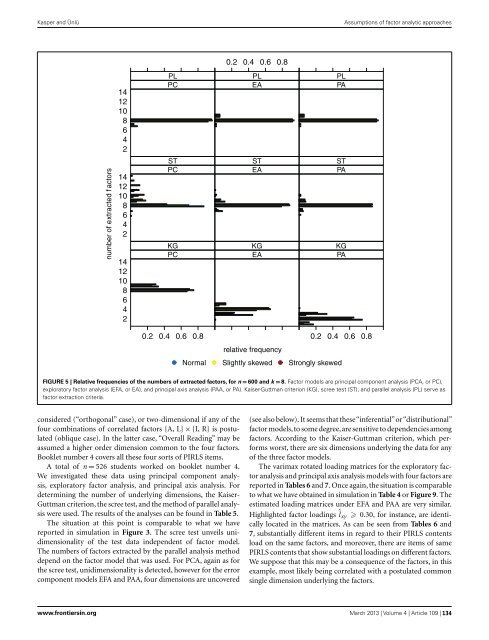Sweating the Small Stuff: Does data cleaning and testing ... - Frontiers
Sweating the Small Stuff: Does data cleaning and testing ... - Frontiers
Sweating the Small Stuff: Does data cleaning and testing ... - Frontiers
- No tags were found...
You also want an ePaper? Increase the reach of your titles
YUMPU automatically turns print PDFs into web optimized ePapers that Google loves.
Kasper <strong>and</strong> ÜnlüAssumptions of factor analytic approaches0.2 0.4 0.6 0.8number of extracted f actors141210864214121086421412108642PLPCSTPCKGPCPLEASTEAKGEAPLPASTPAKGPA0.2 0.4 0.6 0.80.2 0.4 0.6 0.8relative frequencyNormal Slightly skewed Strongly skewedFIGURE 5 | Relative frequencies of <strong>the</strong> numbers of extracted factors, for n = 600 <strong>and</strong> k = 8. Factor models are principal component analysis (PCA, or PC),exploratory factor analysis (EFA, or EA), <strong>and</strong> principal axis analysis (PAA, or PA). Kaiser-Guttman criterion (KG), scree test (ST), <strong>and</strong> parallel analysis (PL) serve asfactor extraction criteria.considered (“orthogonal” case), or two-dimensional if any of <strong>the</strong>four combinations of correlated factors {A, L} × {I, R} is postulated(oblique case). In <strong>the</strong> latter case, “Overall Reading” may beassumed a higher order dimension common to <strong>the</strong> four factors.Booklet number 4 covers all <strong>the</strong>se four sorts of PIRLS items.A total of n = 526 students worked on booklet number 4.We investigated <strong>the</strong>se <strong>data</strong> using principal component analysis,exploratory factor analysis, <strong>and</strong> principal axis analysis. Fordetermining <strong>the</strong> number of underlying dimensions, <strong>the</strong> Kaiser-Guttman criterion, <strong>the</strong> scree test, <strong>and</strong> <strong>the</strong> method of parallel analysiswere used. The results of <strong>the</strong> analyses can be found in Table 5.The situation at this point is comparable to what we havereported in simulation in Figure 3. The scree test unveils unidimensionalityof <strong>the</strong> test <strong>data</strong> independent of factor model.The numbers of factors extracted by <strong>the</strong> parallel analysis methoddepend on <strong>the</strong> factor model that was used. For PCA, again as for<strong>the</strong> scree test, unidimensionality is detected, however for <strong>the</strong> errorcomponent models EFA <strong>and</strong> PAA, four dimensions are uncovered(see also below). It seems that <strong>the</strong>se“inferential”or“distributional”factor models,to some degree,are sensitive to dependencies amongfactors. According to <strong>the</strong> Kaiser-Guttman criterion, which performsworst, <strong>the</strong>re are six dimensions underlying <strong>the</strong> <strong>data</strong> for anyof <strong>the</strong> three factor models.The varimax rotated loading matrices for <strong>the</strong> exploratory factoranalysis <strong>and</strong> principal axis analysis models with four factors arereported in Tables 6 <strong>and</strong> 7. Once again, <strong>the</strong> situation is comparableto what we have obtained in simulation in Table 4 or Figure 9. Theestimated loading matrices under EFA <strong>and</strong> PAA are very similar.Highlighted factor loadings ˆl xy 0.30, for instance, are identicallylocated in <strong>the</strong> matrices. As can be seen from Tables 6 <strong>and</strong>7, substantially different items in regard to <strong>the</strong>ir PIRLS contentsload on <strong>the</strong> same factors, <strong>and</strong> moreover, <strong>the</strong>re are items of samePIRLS contents that show substantial loadings on different factors.We suppose that this may be a consequence of <strong>the</strong> factors, in thisexample, most likely being correlated with a postulated commonsingle dimension underlying <strong>the</strong> factors.www.frontiersin.org March 2013 | Volume 4 | Article 109 | 134














